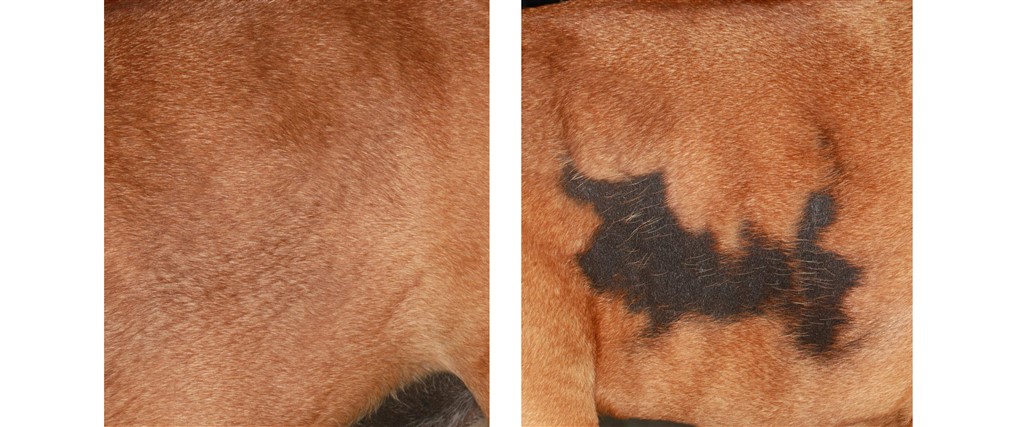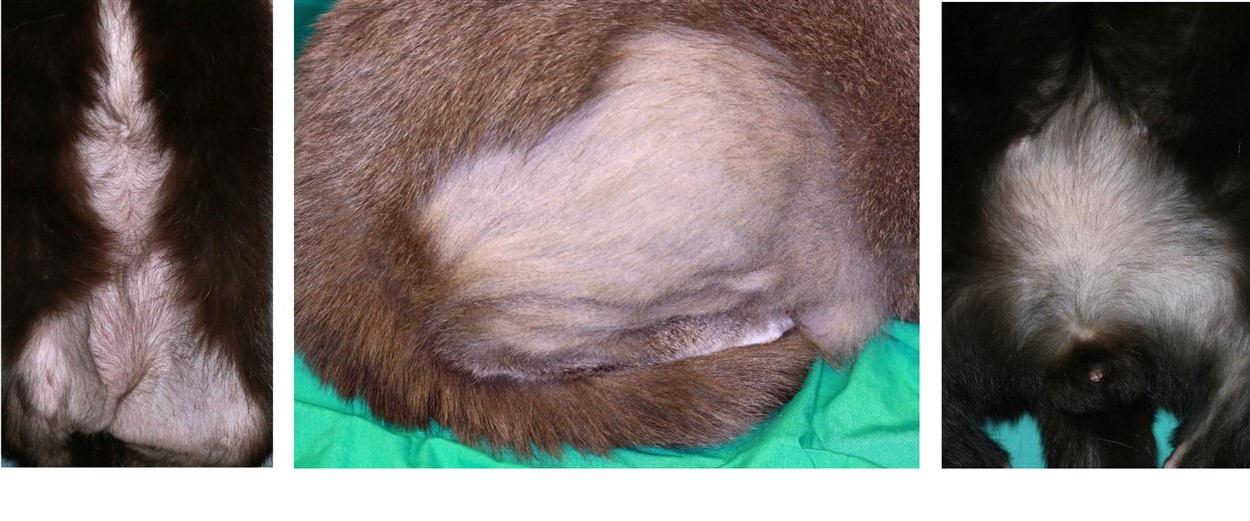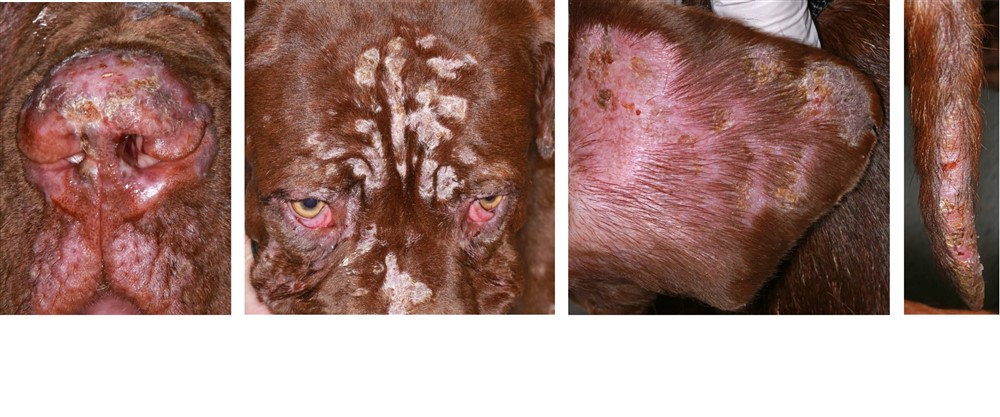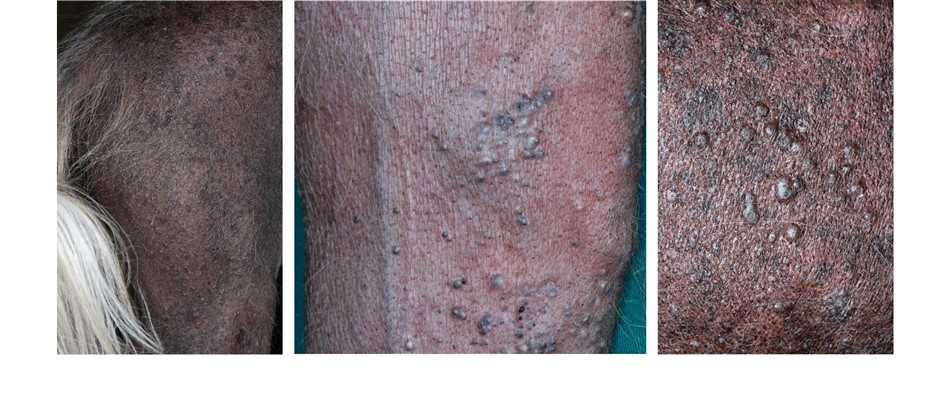This is defined as the partial or complete absence of hair from areas of the body where it normally grows or in more human terms baldness. Causes of alopecia are many & varied.
The commonest cause of hair loss in dogs & cats if self-trauma, whether it be itching, scratching, chewing, biting or rubbing. This behaviour may be openly displayed or can be very secretive (especially with our feline companions). Itch is primarily caused by allergies nowadays rather than external parasites & other much less common primary issues. Please see the other web pages in both the Vet & Clients sections that cover allergic skin disease.
This web page specifically looks at non-pruritic (non-itchy), non-inflammatory, often symmetrical, hair losses
Hair growth is influenced by many hormones secreted by ovaries & testes plus adrenal, thyroid, pituitary & pineal glands. Imbalances, excesses, deficiencies & lack of response to normal levels of hormones have been incriminated in the myriad of alopecic syndromes in dogs (much more so than cats). In some glandular (endocrine) diseases the hormonal implication is well understood & the disorders are clinically well-characterised. Whereas in other alopecic disorders, which outwardly resemble endocrinopathies, the final diagnosis may be more difficult to establish.
I will provide a methodical clinical approach to any canine or feline alopecia case. My clinical approach will incorporate:
![]() A full discussion of Clinical History – breed, age & season of onset, coat colour sexual status, waxing & waning course, spontaneous resolution, progression, general management & husbandry, recently resolved, known or suspected concurrent internal disease, effects pf previous treatments.
A full discussion of Clinical History – breed, age & season of onset, coat colour sexual status, waxing & waning course, spontaneous resolution, progression, general management & husbandry, recently resolved, known or suspected concurrent internal disease, effects pf previous treatments.
![]() Dermatological Examination – primary & secondary lesions, coat & skin colour changes, pattern & distribution of alopecia.
Dermatological Examination – primary & secondary lesions, coat & skin colour changes, pattern & distribution of alopecia.
![]() Further Investigation – targeted by the earlier findings.
Further Investigation – targeted by the earlier findings.
Many alopecic cases will have had a ‘dermatology investigative panel’ completed by sending various samples to an external laboratory. This costly ‘blanket’ diagnostic approach seldom yields useful information. Time constraints &/or lack of experience means a thorough clinical approach was not possible & so the choice of further tests was incorrect.
I consult with many cases who have had poorly chosen, costly blood/serum screening tests – sometimes samples are unnecessarily sent as far afield as the University of Tennessee! Sadly, some pets also undergo inadequate skin biopsy procedures, under anaesthetic, which have often been submitted to laboratories without dedicated veterinary dermato-histopathologists.
I can give fully up-to-date advice on topical & systemic therapy for all alopecic conditions. These can range from ‘masterly inaction’ for purely cosmetic conditions (apart from clothing & sunblock!), hormonal supplementation at optimal dose rates, antimicrobial measures, unlicensed human medications, chemotherapy agents etc. Even the skin care of congenital alopecic breeds can benefit from a dedicated, multimodal, treatment plan.
Here is a List of Alopecic Conditions:
![]() Congenital – Ectodermal defects, Alopecic Breeds Normal (American, Chinese, Mexican, Peruvian), Non-alopecic Breed
Congenital – Ectodermal defects, Alopecic Breeds Normal (American, Chinese, Mexican, Peruvian), Non-alopecic Breed
![]() Acquired – Focal/Multifocal – Infection (Bacteria, Fungal incl. Yeast, Dermatophyte), Leishmaniosis, Ectoparasite – Demodex, Immune-mediated – Vascular, Melanocytic, Mural, Sebaceous, Dermatomyositis
Acquired – Focal/Multifocal – Infection (Bacteria, Fungal incl. Yeast, Dermatophyte), Leishmaniosis, Ectoparasite – Demodex, Immune-mediated – Vascular, Melanocytic, Mural, Sebaceous, Dermatomyositis
![]() Acquired – Symmetric/diffuse – Cancer (Epitheliotropic, Pancreatic/Hepatic etc.), Endocrinopathies (Pituitary, Thyroid, Adrenal, Sex Hormone), Follicular dysplasias (Breed, Black/Red Coat, Dilute Coat, Defluxion (Anagen, Telogen), Pattern
Acquired – Symmetric/diffuse – Cancer (Epitheliotropic, Pancreatic/Hepatic etc.), Endocrinopathies (Pituitary, Thyroid, Adrenal, Sex Hormone), Follicular dysplasias (Breed, Black/Red Coat, Dilute Coat, Defluxion (Anagen, Telogen), Pattern




